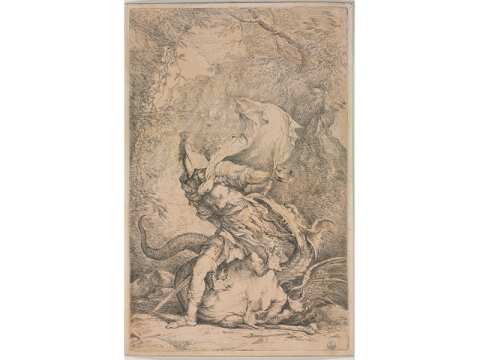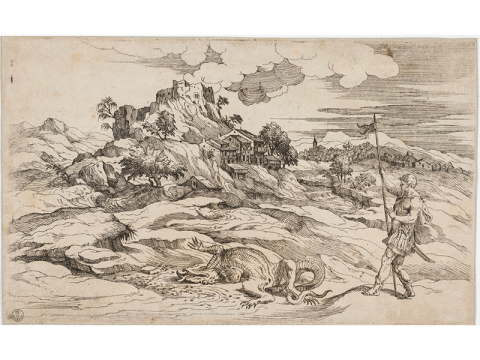Arts
THREE ANCIENT DRAGONS ‘FLY’ TO LUCCA COMICS&GAMES FROM THE UFFIZI
Homage to the 50th anniversary of D&D

Saint George and the Dragon, Cornelis Cort, 1577, (Source: Uffizi Galleries)
USPA NEWS -
The Gallery will pay homage to the 50th anniversary of the birth of the most important fantasy role-playing game, Dungeons & Dragons, by exhibiting three 16th and 17th century engravings with depictions of the legendary monster, taken from Tiziano, Salvator Rosa, Cornelis Cort, in a medieval church in Lucca.
The director Simone Verde announces: the cultural collaboration agreement between the Florentine museum and the great comics event is renewed for another two years.
The director Simone Verde announces: the cultural collaboration agreement between the Florentine museum and the great comics event is renewed for another two years.
Three ferocious, centuries-old dragons to celebrate the 50th anniversary of the most culturally influential fantasy game of all time, Dungeons & Dragons: the Uffizi Galleries are sending them “on an exhibition mission” to this year’s Lucca Comics&Games, as a symbolic tribute to the important anniversary. These are three engravings, all made between the sixteenth and seventeenth centuries, depicting scenes with the most legendary of mythological creatures at their centre.
They were made by some of the greatest artists active between the sixteenth and seventeenth centuries:
Cornelis Cort, after Giulio Clovio, author of Saint George and the Dragon (1577);
Salvator Rosa, Jason Puts the Dragon to Sleep (1663-1664);
Giovanni Battista D’Angolo known as del Moro, after Tiziano, Landscape with Saint Theodore and the Dragon (1560-70).
They were made by some of the greatest artists active between the sixteenth and seventeenth centuries:
Cornelis Cort, after Giulio Clovio, author of Saint George and the Dragon (1577);
Salvator Rosa, Jason Puts the Dragon to Sleep (1663-1664);
Giovanni Battista D’Angolo known as del Moro, after Tiziano, Landscape with Saint Theodore and the Dragon (1560-70).
The monstrous triptych will be exhibited in a more than scenographically suitable context: the medieval church of the Servi, where the Dragons of the Uffizi will also have the opportunity to dialogue with the great exhibition dedicated by Lucca Comics & Games to Dungeons and Dragons, curated by Jon Peterson and Jessica Lee Patterson Gateway to Adventure - 50 Years of D&D Art: over one hundred works of art and memorabilia linked to the fantasy imagery of the game.
Dragons of the Uffizi and Gateway to Adventure will be visible to the public starting at 5 pm on Saturday 26 October.
Dragons of the Uffizi and Gateway to Adventure will be visible to the public starting at 5 pm on Saturday 26 October.
The director of the Uffizi Galleries Simone Verde: “The dragon is perhaps the most famous and beloved of fantasy creatures, to the point of having, already in ancient times, transmigrated from the original Chinese mythology to the collective imagination of all the peoples of the world. In the context of the exhibition of the three beautiful engravings that see him as the protagonist at Lucca Comics & Games, it takes on the symbolic meaning of the cosmopolitan journey of the image, of art, and of the pervasive energy of popular culture, which has always known no borders. Not only that. It is through this initiative, in fact, that the Galleries strengthen the fruitful cultural alliance implemented in recent years with the event: just in these days we have renewed our collaboration agreement for another two years”.
Cornelis Cort, from Giulio Clovio, Saint George and the Dragon, burin, 1577.
The print, belonging to the Uffizi since the second half of the eighteenth century, is signed and dated by one of the greatest Dutch engravers of the sixteenth century, who was active in Italy for a long time. It reproduces a lost work by Giulio Clovio, an important miniaturist of the same century; in his biography of Clovio, Giorgio Vasari recalls a miniature depicting Saint George, donated by Cardinal Farnese to Emperor Maximilian II.Salvator Rosa, Jason Puts the Dragon to Sleep, etching and drypoint, 1663-1664.
Jason is depicted here during the third test for the conquest of the Golden Fleece: the fight with the dragon guarding the precious ram cloak. The Argonaut is immortalized in the act of throwing the magic potion that would make the monster fall asleep on his head. Salvator Rosa returned to this subject several times with studies, drawings and even paintings.G. B. del Moro, Landscape with Saint Theodore and the Dragon, etching, 1560-70.
The engraving reproduces a pen and ink drawing by Tiziano Vecellio, now preserved at the Morgan Library and Museum in New York. The soldier depicted in ancient armor, once thought to be Saint George, is today identified as the patron saint of Venice before Saint Mark, namely Saint Theodore who killed the dragon with a single thrust of his spear, apparently after ordering the beast to freeze. But according to some more recent interpretations, he could even be Cadmus, the Greek hero who became famous for killing the dragon guarding a spring in Boeotia.more information: https://www.uffizi.it
Liability for this article lies with the author, who also holds the copyright. Editorial content from USPA may be quoted on other websites as long as the quote comprises no more than 5% of the entire text, is marked as such and the source is named (via hyperlink).








